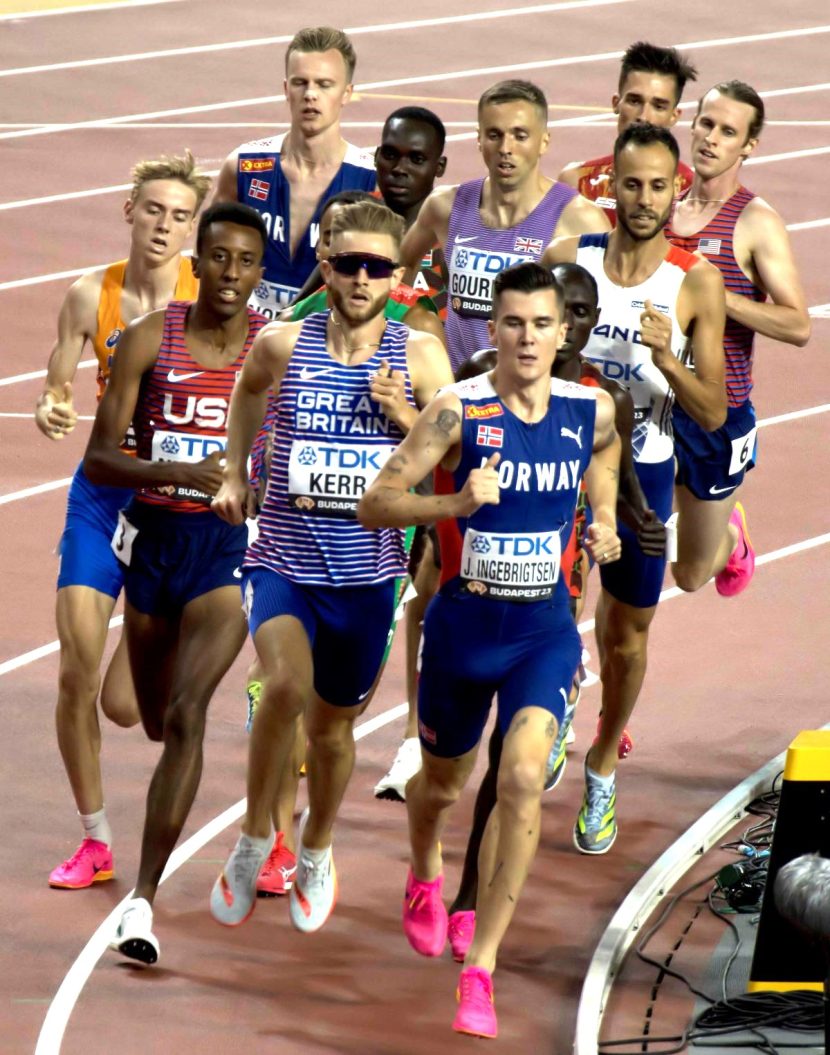The rise of Jakob Ingebrigtsen to become a leading name in middle and long-distance running was no mere coincidence. Behind his achievements and honors is a narrative filled with intent, commitment, and careful strategizing facilitated by his father, Gjert Ingebrigtsen. From an early age, Jakob’s routine was meticulously crafted to mold him into what can […]

The rise of Jakob Ingebrigtsen to become a leading name in middle and long-distance running was no mere coincidence. Behind his achievements and honors is a narrative filled with intent, commitment, and careful strategizing facilitated by his father, Gjert Ingebrigtsen. From an early age, Jakob’s routine was meticulously crafted to mold him into what can only be seen as an exceptional athlete. For him, running transcended being a simple pastime; it was a core part of his upbringing, his family’s essence, and his perspective on life.
While most kids are engaged in school or enjoying carefree adventures, Jakob embarked on an extraordinary journey. By the age of 11, the youngest Ingebrigtsen sibling found himself on a treadmill in a laboratory, undergoing VO2 max tests to enhance his physical limitations. This was not an isolated trial; it marked the start of a demanding expedition. Running over 120 kilometers (75 miles) weekly at such a young age was unprecedented, but for the Ingebrigtsens, it represented the commencement of a purposeful project: sculpting Jakob, step by step, into an elite athlete.
At the heart of this methodology was Gjert’s relentless focus on every detail and his steadfast dedication to creating a discipline-based foundation. As Jakob remembers, the aspiration to be a professional runner was planted when he was merely eight years old. Observing his father’s guidance, Jakob was not treated as an ordinary child chasing dreams. Instead, he was integrated into the rigorous routine that his older siblings, Henrik and Filip—both accomplished international competitors—had already adopted. By 13, he was engaging in professional training programs that would challenge seasoned athletes.
This highly organized upbringing raised concerns about whether it was appropriate to begin elite-level preparation at such a young age. Critics have pointed out that intense training during vital growth phases, particularly during puberty, can lead to both physical and mental strain. Nonetheless, Gjert’s unconventional view remained firm: excellence demands sacrifice. His conviction in thorough preparation and continual progress, which became the defining characteristic of “Team Ingebrigtsen,” effectively redefined many people’s perceptions of long-distance running. Jakob, who embraced this philosophy, made history as the youngest athlete to break the four-minute mile barrier at just 16 years old.
By documenting his family’s experiences on the show *Team Ingebrigtsen*, Gjert unveiled the unseen realities of their training approach. Some admired the accuracy and achievements generated by this methodology, while others expressed discomfort about the oversights that accompanied it. Nevertheless, the outcomes were beyond dispute. Under the guidance of his father, Jakob progressed at an extraordinary pace. Each training session, evaluation, and season was aimed at identifying weaknesses and converting them into strengths. From biomechanics to endurance and mental toughness, every facet of Jakob’s growth was meticulously refined.
This upbringing came with hefty expectations, but it simultaneously fostered an exceptional level of confidence in Jakob. During competitions, his poise and determination belied his years. Leading from the front, he employed tactics that were unconventional for someone so young. His capacity to manage stress, both during races and outside of them, illustrated that crafting the ideal runner involved not only physical conditioning but also nurturing a winning mentality.
For Jakob, the vision that Gjert fostered from his formative years distinguished him from his contemporaries. Every success, from global championships to Olympic gold medals, traces back to a childhood driven by purpose rather than leisure. Although this journey was not without its sacrifices—as the strain on family relationships would later become evident—it undeniably contributed to producing one of the greatest talents the world of athletics has ever witnessed.
Central to Jakob Ingebrigtsen’s ascent to prominence is the highly discussed concept of *double threshold training*. This advanced and demanding technique, initiated and advocated by his father Gjert, became foundational to Jakob’s rise within middle and long-distance running. While the results have been remarkable, the method has ignited intense debates within the athletics community, splitting opinions between those who champion it as a revolutionary strategy and those who argue that it risks pushing athletes to their physical and emotional limits.
To those unfamiliar, double threshold training consists of two intense workout sessions each day, aimed at pushing an athlete to their lactate threshold’s brink. This is where muscles start accumulating lactate faster than the body can eliminate it—a pivotal point for endurance and speed. By training just below this threshold twice a day, Gjert believed that Jakob could consistently improve his body’s efficiency, recover rapidly, and maintain high-intensity performances longer than his competition.
At first glance, this approach appears both methodical and groundbreaking. Additionally, it has proven to be incredibly successful for the Ingebrigtsens. Jakob has obliterated records, routinely delivering astonishing feats that seem almost superhuman. However, many overlook the sacrifices and challenges this regimen involves. Training at this intensity twice daily allows no room for error or complacency. It requires supreme commitment, not merely on the track but across all aspects of Jakob’s life: nutrition, recuperation, rest, and mental focus. Any deviation from perfection carries the risk of burnout, injury, or diminishing returns.
Opponents of double threshold training argue that it may be unsustainable long-term, particularly for younger athletes. Pushing one’s body to its limits repeatedly in a single day may lead to overtraining, which presents itself through reduced performance, weariness, and increased injury susceptibility. The psychological burden is also significant—living under a regimen dictated by performance metrics and split seconds can diminish the joy of the sport and, for some, may induce lasting emotional fatigue. In a sport like running, where passion often propels endurance, this consideration is not trivial.
However, for Jakob, this method has become almost instinctive. In interviews, he frequently attributes his ability to control races with surgical precision to his training routine. He describes being “in tune” with his body, acutely aware of how far he can push himself before hitting his limits. The confidence accrued from countless threshold workouts has endowed him with the calm to command races from the front—a style that many competitors find intimidating. Where others falter in the final laps, overwhelmed by lactic acid and uncertainty, Jakob remains composed, calculated, and seemingly invulnerable.
- However, beneath the façade of triumph lies flickers of vulnerability. Even with his immense skill and resolve, Jakob has exhibited moments of strain. In longer races, such as the Copenhagen Half Marathon, he has sometimes struggled dramatically toward the finish. These cases raise the question: does double threshold training have its limits?
- Another worry voiced by detractors of this approach pertains to its scalability. Is this technique suitable—or even safe—for athletes who do not possess the same natural talents or recovery abilities as Jakob? Misapplied, such a program could have disastrous effects on young, developing runners lacking the professional support or intrinsic resilience to cope with its demands.
- Moreover, the psychological toll of rigorous daily training is not easily brushed aside. For Jakob, growing up immersed in this regimen might have normalized the pressure, but it also tied his self-esteem closely to performance indicators, leading to inquiries about how such conditioning affects the psyche over time.
Despite the vibrant debate surrounding the technique, the substantial impact it has had on distance running cannot be overstated. Coaches globally now study Team Ingebrigtsen’s methods, questioning whether it might hold the key to unlocking their own athletes’ potential—or if it is specific to Jakob’s physical prowess and mindset. Regardless, double threshold training has disrupted conventional thoughts in athletics and necessitated a reassessment of what is achievable in human endurance and middle-distance speed.
For Jakob, this method has been both a blessing and a challenge. It has propelled him to unprecedented success, including Olympic gold medals, numerous titles, and world records. Yet, it has also sown seeds of doubt and raised questions about sustainability, alongside whispers about whether such success comes at an exorbitant price. As more athletes and trainers experiment with this approach, its legacy will reach far beyond the Ingebrigtsen family. Nevertheless, whether it will be remembered as a breakthrough or a cautionary lesson remains to be seen.
The hurdles Jakob Ingebrigtsen faces on the track are dwarfed by the turbulent reality of his personal life, marked by profound familial unrest. Central to this discord is his father and former coach, Gjert Ingebrigtsen. Once celebrated as the architect of Jakob’s remarkable ascent, Gjert has now become a contentious figure, his legacy tainted by shocking allegations of abuse that have destabilized the Ingebrigtsen family.
For many years, Gjert’s role was perceived as straightforward: a father ardently committed to guiding his children toward athletic excellence. However, as Jakob and his brothers have come forward, they have painted a more intricate and painful picture. In 2022, Gjert stepped down from his coaching role, citing health issues, only for deeper rifts within the family to become public knowledge. Jakob and his siblings, Henrik and Filip, disclosed claims of physical violence and emotional abuse they experienced during their formative years—a childhood overshadowed not solely by rigorous training but also by fear and manipulation.
In personal declarations, Jakob and his brothers described their upbringing as one marked by a pervading atmosphere of aggression and intimidation. They alleged that their father employed physical force that significantly exceeded acceptable parenting or coaching methods. “We have grown up with a father who has been very aggressive and controlling,” the brothers stated in a joint communication. “He has used physical violence and threats as part of his upbringing.” These allegations, extending back nearly a decade, reveal a troubling dynamic within Team Ingebrigtsen, where the boundary between discipline and abuse appears to have been crossed.
The gravest accusations involve claims that Gjert “punched,” “kicked,” and even threatened to “beat Jakob to death.” Such accusations are currently under investigation by Norwegian state prosecutors, who have charged Gjert with abusive conduct towards two of his children. The forthcoming trial, scheduled for 2025, is expected to last over eight weeks, calling up to 40 witnesses to reveal the full extent of what transpired behind closed doors.
Gjert has resolutely denied all allegations, insisting that his parenting, although strict, was never violent. “I have never used violence against my children,” he proclaimed in a public address. “While I realize that I have flaws as a father and have sometimes been overly coach-like, this realization has come to me far too late.” Regardless of his denials, the familial strain is evident. Gjert has transitioned from being merely an estranged coach to an antagonistic figure, particularly due to his current coaching role of Narve Nordas, a competitor to Jakob on the international stage.
The situation has further deepened the divide, with Jakob and his brothers taking measures to ensure that they do not encounter Gjert at competitions. During significant events, such as the Bislett Stadium Diamond League meeting and the Paris Olympics, they reportedly received assistance from the Norwegian athletic federation to prevent their father’s presence in the stadium. These steps highlight the extent to which a once-cohesive family has splintered due to alleged violence and a struggle for control in both sport and familial dynamics.
While the remarkable athletic achievements of the Ingebrigtsen brothers are undeniable, the cost of their success is also significant. Jakob, once the youngest sibling idolizing his father’s structured methods, now looks back on a childhood defined by not only athletic prowess but also familial turmoil. Navigating his adulthood and stepping into fatherhood himself, Jakob bears the weight of a legacy that is both glorious and troubled.
The allegations have ignited broader discussions within the athletics community and beyond regarding the intense pressures and sacrifices entailed in cultivating extraordinary talent. To what degree should parents or coaches be permitted to push their children in pursuit of greatness? Where does one draw the line between tough love and abuse? Experiences like Jakob’s underscore how striving for excellence can entail intricate, personal costs that surpass even the rigors of elite sport.
In light of these revelations, Jakob has demonstrated remarkable resolve. He remains steadfast on the track, his focus razor-sharp as he continues to break records and garner recognition. However, off the track, his journey is undeniably one of healing and reflection. Now a married man and a father to his young daughter Filippa, Jakob is set on creating a different narrative—a life where discipline and achievement coexist alongside empathy and love. As he endeavors to balance professional aspirations with personal commitments, Jakob’s story is a testament to the endurance of the human spirit, even amid profound family upheaval.
The trial next year is poised to draw significant global interest, not only for its legal ramifications but also for its emotional depth. It will compel the sports world to confront the costs associated with greatness and reassess the ethics of the methodologies employed in nurturing young talent. For Jakob, this represents both a reckoning with his past and a chance to reshape his legacy, one that thus far has been characterized by both resounding achievements and painful realities.
With the backdrop of personal tribulations woven into Jakob Ingebrigtsen’s existence, his performance on the track is a testament to resilience. His capacity to overcome adversity is perhaps best exemplified in the records he has set and the competitors he has boldly confronted. Jakob’s journey in middle and long-distance running serves as a stunning display of determination, skill, and an audacity that distinguishes him from his peers.
His collection of accolades resembles the ideal résumé of any athlete. Over the years, Jakob has continually redefined excellence in his sport, amassing Olympic gold medals, world championships, and breaking seemingly impenetrable records. Notably, his remarkable 1,500m personal best of 3:26.73 ranks him among the fastest men in history for the event, inching closer to Hicham El Guerrouj’s elusive world record of 3:26.00 that has stood since 1998. This relentless drive for perfection—even against an achievement that many deem almost mythical—epitomizes Jakob’s distinctive mentality: no limit is insurmountable.
Yet the journey to greatness has been far from effortless. Recently, Jakob has encountered fierce rivals who have tested not only his physical prowess but also his mental resilience. British athletes Jake Wightman and Josh Kerr, alongside up-and-coming American talent Cole Hocker, have emerged as significant challengers. Each of these competitors has managed to dethrone Jakob at pivotal moments, emphasizing that even for someone as dominant as Ingebrigtsen, the margin for error at the elite level is razor-thin. Losses to Kerr and Hocker at the 2024 Olympics notably highlighted the increasing competitiveness in middle-distance racing. This served as a humbling reminder that Jakob’s invincibility is not a given.
Nevertheless, the hallmark of a true champion is the capacity to rebound, and Jakob has approached this with a tenacity that leaves his opponents on edge. Following his setback in the 1,500m at Paris, Jakob surged back to seize Olympic gold in the 5,000m—a clear indication not just of his versatility across distances but also of his ability to adapt, recalibrate, and meet challenges head-on. His performance at the Paris Olympics solidified his image as an athlete who confronts adversity, utilizing it as motivation.
Jakob’s rivalry with fellow Norwegian runner Narve Nordas, who became an adversary upon Gjert Ingebrigtsen’s decision to coach him after separating from his sons, adds another fascinating dimension to his narrative. Nordas’ ascent, characterized by near-podium finishes and fiercely contested races against Jakob, underscores that the world of athletics is always evolving. While the pressure of competing against elite runners like Wightman and Kerr is heavy, facing someone with personal ties adds an extraordinary mental hurdle for Jakob. Nonetheless, he continues to compete fiercely, leading from the front, dictating the pace, and challenging his competitors to match his intensity.
Resilience is arguably Jakob’s most astounding trait. Beyond his accolades and rivalries, the emotional weight he carries into each race must not be underestimated. Despite the fractures within his family and the shadow of allegations against his father, Jakob remains fiercely competitive, channeling that energy into his sport. His ability to compartmentalize personal issues reflects his mental fortitude, cultivated through years of intensive training and competition. Still, observers cannot help but ponder how much longer he can continue to withstand the emotional and physical demands of competing at such a high level.
As Jakob looks to the future, it’s evident that he aims for even greater accomplishments. The potential of smashing El Guerrouj’s 1,500m world record tantalizingly looms before him, like a coveted trophy awaiting the right moment to be claimed. It transcends mere timing—it represents a chance to redefine history and cement his status as one of the greatest middle-distance runners ever.
However, Jakob’s tale extends beyond mere triumphs and defeats. It embodies perseverance amidst overwhelming pressure—both on the track and off. It showcases the ability to channel anguish, frustrations, and uncertainty into moments of brilliance, serving as an inspiration to athletes and enthusiasts worldwide. His resilience is far-reaching, extending well beyond his medals, solidifying him as a symbol of tenacity and purpose within a sport that demands nothing short of flawless performance.
As he prepares for his next race, whether it’s a quest for another record or another encounter with his challengers, Jakob Ingebrigtsen exemplifies an unwavering spirit that refuses to allow obstacles to define him. For fans of track and field, witnessing his ongoing journey is a privilege—a reminder that true greatness is not solely about victories but also about the relentless pursuit of excellence against all odds.
Greatness, as alluring as it may appear, frequently carries implications that are seldom apparent on the surface. For Jakob Ingebrigtsen, the toll of extraordinary achievements emphasizes the duality of his existence: one characterized by immense talent and unrivaled success, the other defined by personal sacrifices, emotional healing, and unyielding pressure. Behind every gold medal are years of arduous training, stringent discipline, and, in Jakob’s case, complex personal challenges intricately woven into his biography.
Jakob’s ascent within the realm of athletics is undeniably remarkable. By his early twenties, he had already amassed honors that many athletes might hope to achieve in their entire lifetime. Olympic gold medals, world records, and a reputation as one of the most formidable competitors in middle-distance running painted the picture of an iconic legacy. However, taking a step back from the accolades uncovers a narrative laden with complexities—victories intertwined with turmoil, alongside a relentless quest for excellence that has exacted a toll on him both physically and emotionally.
At the forefront of this cost is the monumental pressure Jakob faces, both from the outside and internally. From a remarkably young age, he has borne the weight of expectations—a burden that has intensified over the years. Although his dominant performances might seem effortless, they result from an inflexible standard that he imposes upon himself. Every defeat, every unmet record, every moment that falls short of ideal becomes an opportunity for critique, scrutiny, and introspection. For someone who has accomplished so much at such a young age, the demand for constant growth can often feel suffocating—an endless race without a finish line.
Moreover, the shadow cast by his family dynamics looms over his achievements. The separation from his father, Gjert Ingebrigtsen, introduced not just a professional split but a deeply personal fracture. The allegations of control and abuse within the family have drawn Jakob into emotional waters uncharted, compelling him to reconcile his professional ambitions with wounds that may still feel fresh. The division has not only severed relationships but has also introduced a climate of tension that permeates every facet of his athletic career—most notably in witnessing his father mentor one of his rivals, Narve Nordas. The emotional implications of such situations would test even the most resilient spirits.
Additionally, the physical costs are significant. Taking one’s body to its ultimate limits carries a steep price, even for someone with seemingly limitless ability like Jakob. The training approach started by his father, while groundbreaking, sows the seeds of a methodology that demands almost flawless execution. Intensive intervals, double threshold sessions, and a regimen that seeks to maximize every ounce of potential have elevated Jakob to the sport’s summit—yet not without setbacks. The rigorous demands of the training regimen occasionally expose the vulnerabilities, even of the most elite. Instances in events such as the Copenhagen Half Marathon, where he notably faded after an excellent start, reveal the price of his extraordinary ambitions. His body, though finely tuned, is not immune to the repercussions of overtraining or the precarious balance between pushing limits and overextending them.
The intertwining of emotional and physical strain manifests with a mental toll that creates a persistent shadow that haunts many top athletes. The mental health struggles of athletes are gradually receiving more attention, and Jakob’s quiet resilience amid personal and professional pressures is commendable. Nevertheless, the recognition of such stoicism does not come without its burdens. Persistently compartmentalizing anguish—whether stemming from familial strife or missed opportunities—can erode the joy of the sport, transforming what was once a passion into a relentless chore.
Perhaps the heaviest burden lies in the uncertainty of what awaits after the race is over. Jakob remains young and at the pinnacle of his career, but the transient nature of athletic fame is an unavoidable reality. For someone whose life centers around purpose and excellence—who has shaped himself within a framework designed with one goal in mind—victory—inevitable questions arise about what life will resemble beyond the finish line. How does one derive happiness when the very pursuit that once provided fulfillment grinds to a halt? Will his legacy overshadow his struggles, or will the costs linger long after the accolades have faded?
And yet, amidst all of this, Jakob Ingebrigtsen continues to run. Each step he takes on the track signifies not just his drive but also his ability to traverse the thin line between triumph and hardship. For each skeptical voice that questions the cost of greatness, he offers a response with each record he continually chases, each rival he overcomes, and every race where he breaks away from the competition. He runs not solely because it’s what he does—but because it defines who he is.
For admirers and followers worldwide, Jakob’s odyssey transcends mere celebration of athletic excellence. It stands as a tribute to human resilience, illustrating that greatness encompasses more than accolades; it also involves the determination to persevere through trials that threaten to overwhelm you. The price of greatness may be substantial, but Jakob, with all his intricacies and contradictions, repeatedly demonstrates that it’s a cost he is prepared to bear.














